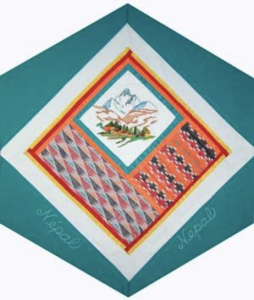Nepal

The Block
An embroidered rendering of the majestic Himalayas rises above a typical Nepalese village in this block. Intricately patterned examples of weaving, one of the country’s oldest and most important crafts, frame the scene. Weaving, which is believed to be work favoured by the gods (particularly Goddess Saraswati, the divine patroness of weavers), is traditionally performed by women and the skill has played a vital role in Nepalese life for many years. People living in the cold mountain areas without adequate heating depend on their woven fabrics for warmth and survival. For many, it is also a much-needed source of income.
Paul Mahler contributed the hand-made weaving on the block, one of which is from a traditional topi, the national cap worn by men. These pieces feature Dhaka cloth worked in customary colours. Dhaka weaving has its origins in Nepal’s eastern regions where historically it was used to cover religious manuscripts as well as for articles for daily living. It is presently used for caps, women’s blouses, shawls, clothes for special occasions, bags, and bed and cushion covers.
Cultural Profile
Nepal is a small landlocked country situated between China and India. It is divided into four topographical regions: the Great Himalayas, the Middle Himalayas, the Outer Himalayas and the Tarâi. It is in the Great Himalayas zone that eight of the world’s ten highest mountains––including Mount Everest (called Sagarmatha or ‘goddess of the sky’ by Nepalese)––are wholly or partially located. The Tarâi’s fertile soils make up a major agricultural area of the country, where almost half the inhabitants live. Agriculture dominates Nepal’s economy as most people derive their income from this sector.
The nation’s diverse population is comprised of over 40 different races and tribes. These include the eastern mountain Sherpas, known for their climbing skills, the Gurkhas, famous for their courage and military skills, and the Kathmandu Valley Newars, known for magnificent wood carvings. Nepali, related to Sanskrit, is the official language, although each ethnic group also has its own language or dialect.
Some ethnic groups in Nepal are categorized according to their occupations, which include Damais (musicians and tailors), Khibis (washermen), Sarkis (cobblers), and Gaines (once fishermen but now travelling minstrels). In the country’s predominantly rural society, village activities revolve around the family. Traditional dances include masked dances telling stories of gods and heroes. Music is as varied as the country’s ethnic groups. The instruments, some preserved since ancient times, include the four-stringed, hand-carved saringhi. Festivals also occupy a large place in Nepalese society, the longest and most important being Dashain. Lasting fifteen days, it is an occasion for most Nepalese to return home and participate in family gatherings and religious processions.
National crafts include, silver and gold jewelry set with turquoise and coral, and cottage industries like spinning and basket weaving. The dokos, large baskets made of bamboo, are strapped on the wearer’s forehead, allowing him or her to carry loads weighing up to 50 kg. Rug weaving plays a major role in the Nepalese economy today. This art form became prevalent after 1959, when a large influx of Tibetan refugees came to Nepal and started making and selling rugs as a way of subsistence. These rugs feature traditional Tibetan geometric designs, or floral design inspired from Chinese designs, in red, indigo, yellow, brown and grey obtained from natural dyes. Nepalese knitwear can also be found around the world, especially the iconic warm Sherpa hat.
Many Nepalese came to Canada for social and economic reasons. They have settled across the country, with the largest communities in Ontario. Nepalese have established a number of organizations throughout Canada, including the Nepalese Canadian Association of Ottawa, the Nepalese Canadian Society of Edmonton, Association of Nepalese in Quebec, and the Nepal Cultural Society of British Columbia. They have created language schools and currently maintain various festivities, such as the Dashain Celebration, to preserve and promote their culture. As of 2011, there were over 9,700 people of Nepalese ancestry living in Canada.
Sponsor: Ralph & Monica Hainer, Geoffrey, Kirstin, Sarah and Anne
